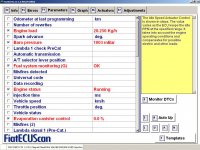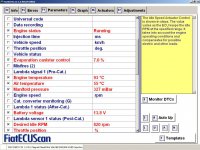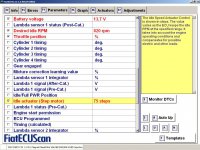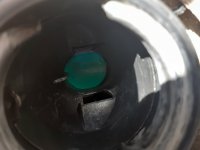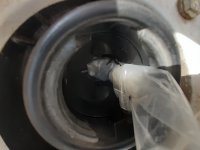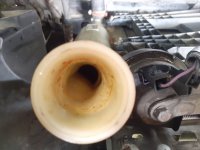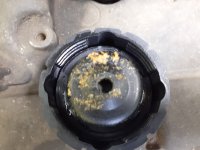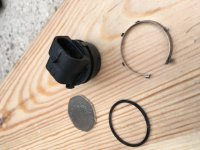Mike1alike
Established member
The engine revs repeatedly to 2000 RPM. But it's not like when it's a vacuum leak, the acceleration increases smoothly and lasts several seconds on a vacuum leak, but it's a jerky and repeated rev, it goes up to 2000, it doesn't stay for more than a second, then it goes down and repeats indefinitely if I don't stop the engine or put the car in motion. So, I think the problem is all the time, but at idle it is very obvious, through this repeated raising of the revs.
Here are some recorded parameters, in the attached photos.
I'd say it stands out the following:
Engine load: from 7.5kg/h on normal functioning, it increases up to 20kg/h. A little detail, on cold start engine works nice, the problem appears when engine gets hot.
Evaporation canister control: it became active although when I did this test I did not move the car, it was parked all day but the atmospheric temperature was very high. In fact, this is how this problem first appeared, after I refueled and the pump kept blocking, I wonder if gasoline did enter into carbon filter (is that possible?) when I refueled. So it had oscillating values, it moved between them, returning to 0 between the other values and continuing this dance.
I suspected the coolant temperature sensor, but it indicates the actual temperature in the computer. It started at 75C (I had started the engine before) and then it kept rising, as I said, it seemed to me that it indicated the correct temperature, I don't think the problem is from here.
Idle actuator (Step motor): had high values, much higher than the normal ones for idling, I think it was also 90. But I do not think there is a problem here, I think the ECU gave this higher opening command due to that increased Engine load recorded.
Another detail: having the windows open during the test, it seemed to me that there was a smell of burnt / hot rubber.
My first suspect is the accessory pulley on the flywheel. Its disc consists of 2 metal parts attached to each other with rubber, inside (it is not visible). At a glance there are no traces of molten rubber on the body of the pulley. But as the car manifests, with this repeated and jerky increase in speed, this pulley is my first suspect.
Any other ideas?
Here are some recorded parameters, in the attached photos.
I'd say it stands out the following:
Engine load: from 7.5kg/h on normal functioning, it increases up to 20kg/h. A little detail, on cold start engine works nice, the problem appears when engine gets hot.
Evaporation canister control: it became active although when I did this test I did not move the car, it was parked all day but the atmospheric temperature was very high. In fact, this is how this problem first appeared, after I refueled and the pump kept blocking, I wonder if gasoline did enter into carbon filter (is that possible?) when I refueled. So it had oscillating values, it moved between them, returning to 0 between the other values and continuing this dance.
I suspected the coolant temperature sensor, but it indicates the actual temperature in the computer. It started at 75C (I had started the engine before) and then it kept rising, as I said, it seemed to me that it indicated the correct temperature, I don't think the problem is from here.
Idle actuator (Step motor): had high values, much higher than the normal ones for idling, I think it was also 90. But I do not think there is a problem here, I think the ECU gave this higher opening command due to that increased Engine load recorded.
Another detail: having the windows open during the test, it seemed to me that there was a smell of burnt / hot rubber.
My first suspect is the accessory pulley on the flywheel. Its disc consists of 2 metal parts attached to each other with rubber, inside (it is not visible). At a glance there are no traces of molten rubber on the body of the pulley. But as the car manifests, with this repeated and jerky increase in speed, this pulley is my first suspect.
Any other ideas?


